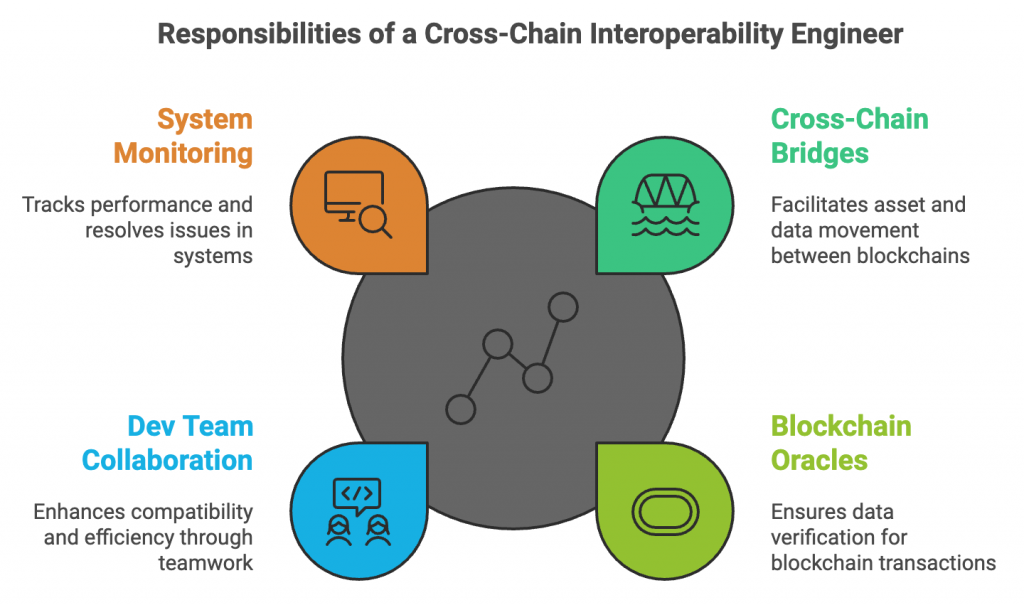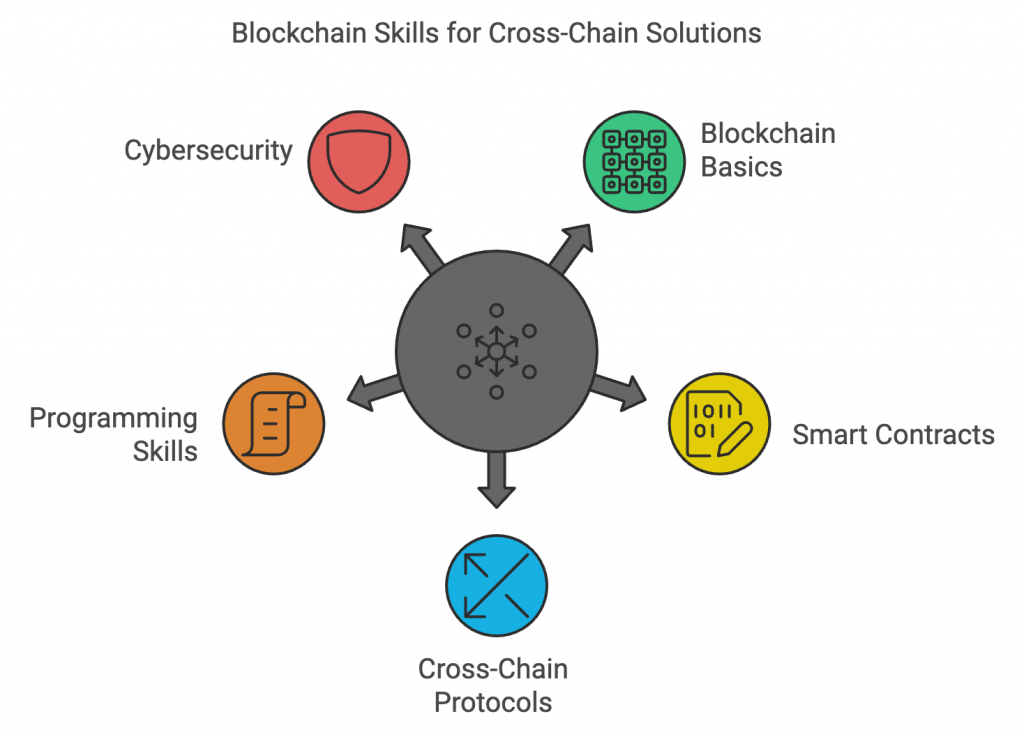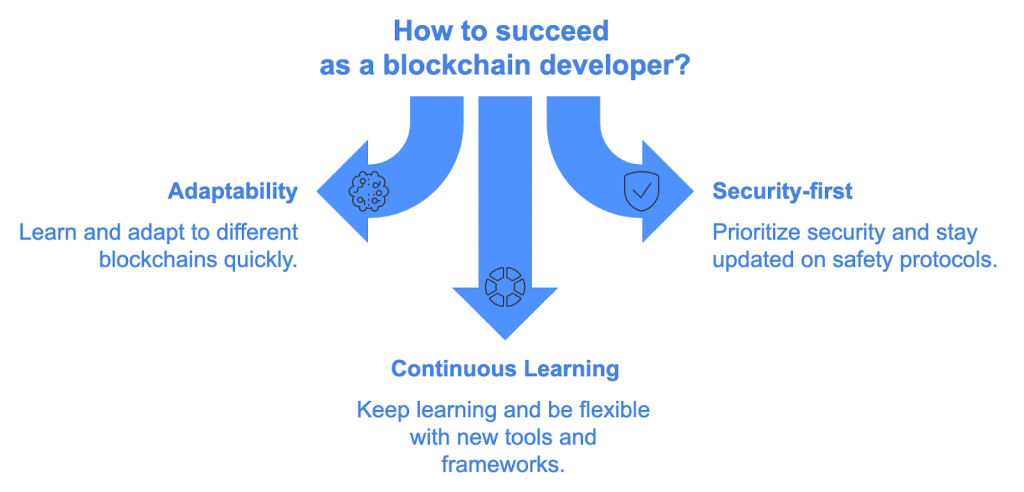How to Become a Cross-Chain Interoperability Engineer: Skills and Career Guide
The blockchain space is evolving fast, and while having separate blockchains is excellent, making them work together seamlessly? That’s where cross-chain interoperability engineers come in. This role is perfect for those who love challenges and want to be at the forefront of blockchain tech. So, what does it take to step into this space? Let’s unveil the skills, career paths, and what becoming a cross-chain interoperability engineer is like.
What Exactly Is a Cross-Chain Interoperability Engineer?
Think of a cross-chain interoperability engineer as someone who ensures different blockchains can talk to each other. Whether transferring tokens, sharing data, or ensuring smart contracts work across chains like Ethereum, Solana, and Polkadot, this role connects the dots in the blockchain world.
Main Responsibilities:
- Building and managing cross-chain bridges, allowing assets and data to move between blockchains.
- Creating or working with blockchain oracles for data verification.
- Collaborating with blockchain dev teams to ensure compatibility and efficiency.
- Monitoring the performance of these cross-chain systems and debugging any hiccups.

Must-Have Skills
You’ll need a unique set of skills to excel in this role. Here’s the rundown:
1. Understanding the Basics of Blockchain
Before you can link blockchains, you need to understand how they work. Each blockchain has its unique way of handling transactions and securing data. You need to know consensus mechanisms like Proof of Work (PoW) and Proof of Stake (PoS).
Pro Tip: Start learning about the big names like Ethereum, Solana, and Polkadot. Each has special quirks you’ll have to know to create effective cross-chain solutions.
2. Smart Contract Wizardry
Smart contracts are the backbone of blockchain interactions. You need to be skilled in writing and debugging smart contracts to enable cross-chain capabilities. Most developers use Solidity for Ethereum and Rust for Solana, so ensure these are in your toolkit.
Tools to Check Out:
- Remix IDE for writing and testing Solidity code.
- Solana Playground for experimenting with Rust.
- Truffle and Hardhat for a deeper dive into contract development.
3. Knowledge of Cross-Chain Protocols
This is where things get specialized. You need to understand how existing cross-chain solutions work. Projects like Cosmos’ IBC (Inter-Blockchain Communication) and Polkadot’s XCMP (Cross-Chain Message Passing) lead cross-chain tech.
4. Programming Skills
Strong coding skills are a must. You’ll want to be proficient in languages like JavaScript, Python, and Golang for building cross-chain applications and backend support.
Insider Tip: Learning Rust is a game-changer if you’re diving into Polkadot or Solana. It’s becoming the go-to language for developers working on high-performance blockchain projects.
5. Cybersecurity and Cryptography
Safety first! Blockchain is all about security, and the stakes are even higher when you’re linking different networks. Understanding cryptographic principles, hashing, and encryption is key to ensuring your solutions don’t become a hacker’s playground.

Your Path
Step 1: Learn the Blockchain Basics
Get familiar with blockchain concepts and how different networks function. Free courses from Coursera, edX, or blockchain-focused platforms are great starting points. You don’t necessarily need a computer science degree, but a solid understanding of programming and blockchain fundamentals will make things easier.
Step 2: Build and Experiment
Start coding! Create simple dApps or smart contracts that run on Ethereum or Solana. This is where you’ll learn by doing. Once comfortable, move to more complex projects connecting two or more blockchains.
Project Ideas
Step 3: Contribute to Open-Source Projects
Jump into the open-source world on platforms like GitHub. Contributing to existing projects will expose you to how professionals handle cross-chain challenges and teach you about real-world problems and solutions.
Projects to Check Out
Step 4: Get That First Job or Internship
Once you have some hands-on experience, it’s time to apply for jobs. Start with entry-level blockchain developer roles if you can’t find a specific cross-chain position immediately. You’ll gain valuable experience and can specialize as you go.
Job Boards to Visit:
- CryptoJobsList
- AngelList

Salary Expectations
The salary range for cross-chain interoperability engineers is attractive, given the demand for skilled talent.
Challenges You’ll Face (and How to Handle Them)
Complex Blockchain Differences. Each blockchain works differently, so you must adapt and learn quickly. Be ready to switch gears and keep your knowledge fresh.
Security Risks. Cross-chain solutions can be vulnerable to hacking and exploits. Always prioritize security in your development and keep up with the latest blockchain safety protocols.
Fast-Moving Industry. The blockchain world evolves almost overnight. Keep learning and be flexible enough to adopt new tools, languages, and frameworks as they emerge.

Wrapping It Up
Becoming a cross-chain interoperability engineer is one of the most exciting career paths in the blockchain world. It’s challenging, yes, but also advantageous. If you’re passionate about tech, love problem-solving, and want to work on groundbreaking projects, this could be your perfect role. Start with the basics, build your skills, contribute to open-source projects, and stay updated on the latest trends. The blockchain world is full of opportunities, and being an engineer who can bridge these worlds puts you right in the center of the action.



